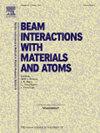Assessing the L X ray satellite emissions of zirconium through wavelength Dispersion X ray fluorescence (WDXRF) analysis
IF 1.4
3区 物理与天体物理
Q3 INSTRUMENTS & INSTRUMENTATION
Nuclear Instruments & Methods in Physics Research Section B-beam Interactions With Materials and Atoms
Pub Date : 2025-05-20
DOI:10.1016/j.nimb.2025.165740
引用次数: 0
Abstract
The technique known as Electron Probe Microanalysis (EPMA) is used to precisely identify the elemental composition of small regions in solid materials. A concentrated electron beam is directed onto the sample, producing distinctive X-rays in the process. After that, the elements’ presence and concentration in the material are ascertained by analyzing these X-rays. For this analyzing purpose, Wavelength dispersive X-ray fluorescence (WDXRF) is used because of its high accuracy compared to Energy dispersive X-ray Fluorescence (EDXRF). In this work zirconium foil is analyzed and the experimental values to the theoretical energies of these satellite lines was confirmed using the literature by using WDXRF. And using two crystal changers, Poly Ethylene Terephthalate (PET) and Extended selection of Germanium Crystal (XS-Ge), WDXRF was used to compare the theoretical values from X-Ray Data to the experimental values from the WDXRF Technique, and found the transitions of L2O1 and L3O1 experimental values which are not found theoretically, chemical effect, such as energy shift, intensity ratio, and transition energy corresponding to emission X-ray intensity and their respective functions of zirconium foil.
利用波长色散X射线荧光(WDXRF)分析评估锆的L X射线卫星发射
电子探针微分析(EPMA)技术被用来精确识别固体材料中小区域的元素组成。一个集中的电子束被引导到样品上,在这个过程中产生独特的x射线。然后,通过分析这些x射线来确定材料中元素的存在和浓度。由于波长色散x射线荧光(WDXRF)与能量色散x射线荧光(EDXRF)相比具有更高的精度,因此用于该分析目的。本文对锆箔进行了分析,并利用WDXRF对这些卫星线的理论能量进行了验证。利用WDXRF技术,利用聚对苯二甲酸乙二醇酯(PET)和扩展选择锗晶体(XS-Ge)两种晶体交换剂,将x射线数据的理论值与WDXRF技术的实验值进行了比较,发现了理论上没有发现的l201和L3O1实验值的跃迁、能量位移、强度比、和与发射x射线强度对应的跃迁能及其各自的函数。
本文章由计算机程序翻译,如有差异,请以英文原文为准。
求助全文
约1分钟内获得全文
求助全文
来源期刊
CiteScore
2.80
自引率
7.70%
发文量
231
审稿时长
1.9 months
期刊介绍:
Section B of Nuclear Instruments and Methods in Physics Research covers all aspects of the interaction of energetic beams with atoms, molecules and aggregate forms of matter. This includes ion beam analysis and ion beam modification of materials as well as basic data of importance for these studies. Topics of general interest include: atomic collisions in solids, particle channelling, all aspects of collision cascades, the modification of materials by energetic beams, ion implantation, irradiation - induced changes in materials, the physics and chemistry of beam interactions and the analysis of materials by all forms of energetic radiation. Modification by ion, laser and electron beams for the study of electronic materials, metals, ceramics, insulators, polymers and other important and new materials systems are included. Related studies, such as the application of ion beam analysis to biological, archaeological and geological samples as well as applications to solve problems in planetary science are also welcome. Energetic beams of interest include atomic and molecular ions, neutrons, positrons and muons, plasmas directed at surfaces, electron and photon beams, including laser treated surfaces and studies of solids by photon radiation from rotating anodes, synchrotrons, etc. In addition, the interaction between various forms of radiation and radiation-induced deposition processes are relevant.

 求助内容:
求助内容: 应助结果提醒方式:
应助结果提醒方式:


